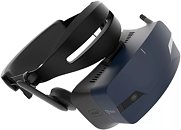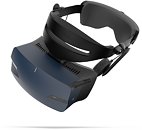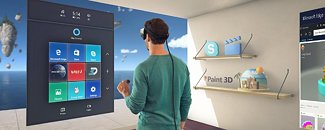Raevenlord
News Editor
- Joined
- Aug 12, 2016
- Messages
- 3,755 (1.18/day)
- Location
- Portugal
| System Name | The Ryzening |
|---|---|
| Processor | AMD Ryzen 9 5900X |
| Motherboard | MSI X570 MAG TOMAHAWK |
| Cooling | Lian Li Galahad 360mm AIO |
| Memory | 32 GB G.Skill Trident Z F4-3733 (4x 8 GB) |
| Video Card(s) | Gigabyte RTX 3070 Ti |
| Storage | Boot: Transcend MTE220S 2TB, Kintson A2000 1TB, Seagate Firewolf Pro 14 TB |
| Display(s) | Acer Nitro VG270UP (1440p 144 Hz IPS) |
| Case | Lian Li O11DX Dynamic White |
| Audio Device(s) | iFi Audio Zen DAC |
| Power Supply | Seasonic Focus+ 750 W |
| Mouse | Cooler Master Masterkeys Lite L |
| Keyboard | Cooler Master Masterkeys Lite L |
| Software | Windows 10 x64 |
ACER at IFA 2018 announced a new Windows MR headset, with improved build quality and features compared to its first product for that particular market. The OJO 500 features a very respectable 100º FOV, and its two 2.89-inch. 2880x1440 panels offer the 90 Hz refresh rate that's so important for nausea prevention in this kind of setups. There's integrated audio with what Acer calls a "patented sound pipe" that moves sound from the headset's speakers directly to users' ears - and there's a built-in mic array.
Upgrades to the body of the headset mean that the lens casing and strap (in a hard or soft version, with the latter being machine washable) can now be easily removed for easier cleaning duties, and the visor can be lifted so you can actually see what's going on in the real world. Other quality of life (and image quality) improvements include an IPD (Inter Pupillary Distance) dial that allows you to regulate for better image quality and visualization comfort. Two motion controllers will be bundled with the headset, which features inside-out tracking and 6 DoF (Degrees of Freedom). The headset comes with a 4 meter (13 feet) cable, and connects to a PC via HDMI 2.0, while a USB 3.0 connector downloads data (no VirtuaLink support as of yet). It will be available come November of this year for $399 in the US and for a much more eye-watering €499 in the EMEA.




View at TechPowerUp Main Site
Upgrades to the body of the headset mean that the lens casing and strap (in a hard or soft version, with the latter being machine washable) can now be easily removed for easier cleaning duties, and the visor can be lifted so you can actually see what's going on in the real world. Other quality of life (and image quality) improvements include an IPD (Inter Pupillary Distance) dial that allows you to regulate for better image quality and visualization comfort. Two motion controllers will be bundled with the headset, which features inside-out tracking and 6 DoF (Degrees of Freedom). The headset comes with a 4 meter (13 feet) cable, and connects to a PC via HDMI 2.0, while a USB 3.0 connector downloads data (no VirtuaLink support as of yet). It will be available come November of this year for $399 in the US and for a much more eye-watering €499 in the EMEA.




View at TechPowerUp Main Site





